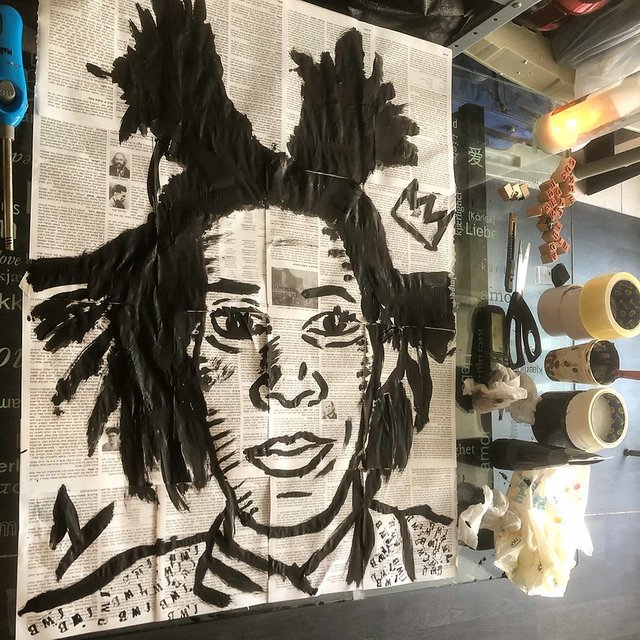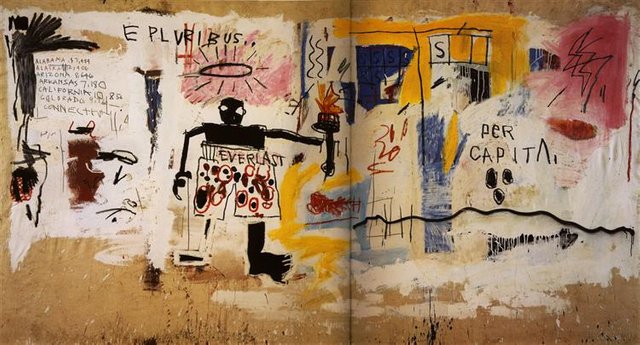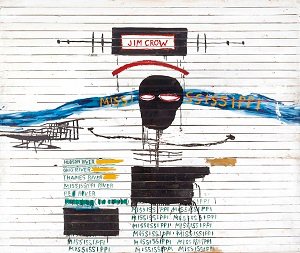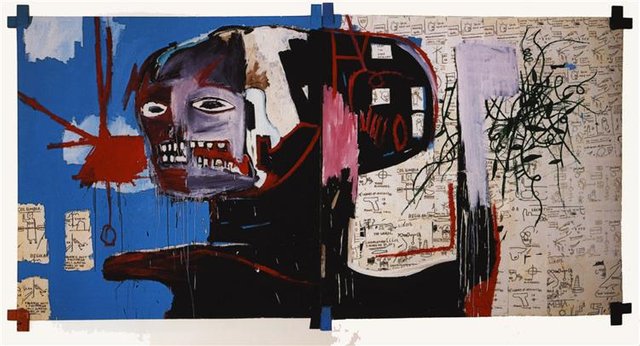Jean Michelle Basquiat's works - interpretation with the movie mediation
.jpeg)
Jean Michelle Basquiat's works - interpretation with the movie mediation.
I love the work of Jean Michelle Basquiat and with the greatest pleasure, I present this love to anyone who only wants to listen to me. Recently, while reading the posts of various users on steemit, I have come across the information that modern art is incomprehensible, unpleasant in reception because it causes anxiety and chaotic thoughts. Of course, I fully respect this approach and do not value people for better and worse because of the preferred trends in painting (it would be ridiculous, I hope no one does, maybe except my former art history professor, but she was always a weirdo), but in case the antipathy to modern art was motivated by a lack of appropriate tools for interpretation, and not by private tastes, I found that I can give some hints on how to interpret it.
Of course, in some situations, modern art has more than one possible interpretation. Sure, most of the authors have something in mind when creating the painting, but postmodernism sometimes implies openness to new interpretations, allowing us to be guided by our own intuition and evoked emotions. However, if we want to interpret a painting as an art critic and get closer to understanding the original message of the work, we must learn about the artist's biography, preferably his other works, and often use the mediation of other media too.
At this point, the reader should be familiar with the concept of mediation. Mediation is the arbitration of a dispute to help the sides reach an agreement. Obviously, mediation should not be interpreted literally in this case. The dispute here is the impossibility of interpreting a given work, and the individual sides are represented by the artist, with his idea, and the viewers who have their own idea of the symbolism of the painting.
In my work, I would like to pay special attention to the aspect of mediation with movies, because it seems that it is the most accessible medium, often pleasant to use. A person starting their adventure with art will sooner watch a few movies before an exhibition than read numerous books, interviews, scientific works, etc. Such films, of course, documentaries and/or based on facts but fictionalized, are a valuable support tool.
To prove my thesis, I will analyze a few images myself. An example will be Jean-Michel Basquiat and his three works: "Per Capita", "Jim Crow" and "La Colomba". Various films will help me in this: "Basquiat - The radiant child", "Basquiat", "Jean Michel Basquiat" and tapes with recordings of his interviews and interpretations of his paintings by art critics.
The artist's image - a short biographical note
Before I move on to the interpretation of individual painting positions, it is worth quoting a few facts from the life of Jean-Michel Basquiat, because, as we know, it is impossible to interpret works without knowing the history of the artist and the environment in which he created. To prove that proper mediation can make a specialist of anyone, even the person who didn't hear about the artist before, I will base this short note only on the information contained in the movies, quoted by me above in the text.
Jean Michel-Basquiat came from a multinational family living in the United States. His mother was from Puerto Rico. Thanks to her he knew how to speak Spanish. When Basquiat was young, health problems forced her to stay in a psychiatric hospital, where she remained until her death. Basquiat was incredibly attached to her, as can be seen from the numerous works in which he posts her directly or indirectly (using drawings from the book "Gray's Anatomy", which she once gave him). His father was from Haiti. Thanks to him, Basquiat could also communicate in French. The wealth of the family represented a typical middle class.
Basquiat spent the rebellious period of his teenage on the streets. At 17, he ran away from home and moved to Square Park. For days he wandered the streets looking for ideas to express his creative ambitions. He took up graffiti, signing his work with the nickname SAMO (shortcut to "same old shit"). He was different from the others. He combined street art with higher art, creating true poetry. His graffiti has always accurately criticized the existing situation - they referred to globalization, commercialization, discrimination, internal and external politics of the United States, but also to existential issues. The SAMO brand quickly became recognized throughout the city.
Jean-Michel was earning the money for sprays and for a living by selling self-made postcards and T-shirts with his own prints. In his free time, he experimented with music, starting the band "Gray" (the title also came from the previously mentioned book given to him by his mother). Music in general was an extremely important issue for him. In his later works, you can see many references to jazz and the biographies of the most important jazzmen. He used to listen to "Bolero", Ravel, each time he was painting.
Many people contributed to his success: Andy Warhol (a great friend, they created many projects together), Annina Nosei (promoted him, helped to get first fans), William Burroughs, and John Giorno. None of them, however, had a direct influence on the shape of Basquiat's works, because he did not want to hear any opinions about his works other than those presented in superlatives (this rule also applied to his closest friends). Indirectly, however, some of his paintings existed only because of those people. How? Basquiat was painting inspired by everyday life. He intertwined other people's statements, TV events, etc. into his art.
He also often referred to classic painters. It was not, however, copying their art. Staying in the influence of some work, he created his own - incredibly strong overtone. It is as if someone else's thought from the history of painting was flowing through his new, completely different mind. Influences are therefore not traditional influences when it comes to Basquiat's works, eg Venus de Milo sketched in one painting, symbolizing the artist's entry into art history.
In his painting, African themes are compared with the culture of the West, jazz and poster ones, were perceived, the artist himself also spoke of being inspired by cartoons or Picasso. He mentions "Guernica" by this artist as the first painting that made an impression on him.
Jean-Michel Basquiat saw canvas in every material - when he had no money he painted on old doors and windows. The explosion of painting collages in his works has never been described by him personally. Their cube-shaped fragments contained the entire galactic nature, were very diverse, full of content, realistic (although at first glance it would seem that there is no realism at all, it manifests itself more in the content rather than in the form). While his work appears to be random, every tiniest brushstroke is deliberate.
Basquiat is also famous for introducing a certain innovation by combining sculpture and painting in a non-academic way. There is no academic calculation in all of his works, they are replaced in his case by instinct.
It is also impossible not to mention his self-destructive love for drugs. Transvisions helped him create many artistic works but ultimately contributed to the premature death of the artist.
Painting analysis - "Per Capita"
The first image I have chosen to analyze is Per Capita, a work that deals with capitalism, economic inequality, and exploitation.
The American economy is represented here by the word "per capita", dollar signs, or the Latin phrase "E Pluribus" appearing on the US currency. Products compared with a black man, says about the wealth and its distribution (at the expense of third-world workers).
"Per Capita" is a collage of paintings and texts. The picture includes states in alphabetical order along with their per capita income. The huge difference between incomes has been highlighted. In this way, the artist wishes to convey that inequality is essential in human existence, in this case, financial inequality.
The black figure, symbolizing getting rich by the cost of others, is wearing boxing shorts. This is a theme that appears frequently in Basquiat's work. In this way, he refers to those who inspired him - Sugar Ray Robinson, Joe Louis, and Mohammed Ali, black athletes. The presence of boxers in shorts combined with economic symbols in the picture can be interpreted as contemporary exploitation of African Americans through the sport and entertainment industry. Behind the thesis which would prescribe such an interpretation is another painting by Jean-Michele about this very form of exploitation, "St Joe Louis".
A black boxer holds a flashlight in his hand. The torch is here to symbolize rebellion, leadership, and light. The sportsman considers himself a hero, a person who gives hope to other black people of the United States: hope for success, respect, fulfillment ... meanwhile, he remains only a tool for manipulating others.
The picture speaks primarily of the sin of greed. It may be referred to by the multiplied "S" in the image (from "sin"). "S" can also refer to "south", south of the country that struggled to maintain slavery.
The color of the painting itself is also not irrelevant. The work itself is gray, but its content is set against a white background. The white seems to be moving south, breaking into the gray area of the painting. There are no such things in the top, right, and left parts where the boundaries have been clearly defined. Perhaps Basquiat is trying to show by this procedure that the economic expansion of the first world countries is still progressing. In the age of consumerism, the desire to get new things is never satisfied. The people of the United States are gaining more and more items at the expense of a growing number of third-world citizens.
Painting analysis - "Jim Crow"
The painting, although it seems to be made on a piece of notebook paper, was in fact painted on a wooden board. The technique used by Jean-Michel Basquiat is using black and colored markers.
Basquiat in the lower part of the picture listed the different rivers: Hudson, Ohio, Thames, etc. One of them he pointed by repetition - the Mississippi. A thick blue strand stretching throughout the work is to additionally visualize the river. Its extended name ("Missississippi"), on the other hand, indicates the impressive length, the enormity of the water (but also the amount of discrimination that characterizes the southern states, about which later).
The central part of the painting is a black skeleton painted with a marker, with the sign "Jim Crow" above it. What does mean by this inscription placed frontally in the work and at the same time its title? Jim Crow is a colloquial, contemptuous term for an African American. Jim Crow law was introduced in the southern states shortly after the Civil War and was intended to restrict the freedoms of former slaves.
The whole picture is referring to the South - the state and the Mississippi River are located in the south of the United States, the whitewashed wood on which the painting was made is a regional element from there, and finally a black skeleton, the symbol of African-American enslavement.
Jim Crow is a typical southern rural painting but juxtaposed with metropolitan graffiti art. That way the author could make a double reference to the past - referring to the slavery origin of the USA and his own artistic origin as the graffiti maker (SAMO). The picture is full of disproportions - ruralness is associated with peace, idyll, while street art is created quickly, violently, and is characterized by a certain aggressiveness.
The analysis of "deep south" is not accidental here. As you may know, Jean-Michel Basquiat was the first African-American painter in the country who went so far in his artistic achievements. He felt alienated, marginalized by his origin. He also did not forget about the many unpleasant situations that happened to him in the past because of his skin color. It should be mentioned that the America of the 1980s was not as tolerant as it might seem. Although the discriminatory law promoting universal segregation was abolished in the 1960s (so it also applied to Basquiat's parents), prejudices remained largely unchanged. The “Deep South” was doubly doomed to this discrimination: firstly, the mentality of its inhabitants was more conservative than in the northern states, and secondly, the south was inhabited by many more excluded people.
The figure itself depicted in the painting is inspired by the illustration from the textbook "Gray's Anatomy", which I have already mentioned. The character was even signed in a textbook-specific way (unfortunately you cannot see it in the picture), as FIG 23 (figure 23). Perhaps by putting the African American as an object ("figure") worth studying, Basquiat presents the skewed stance of racists regarding blacks as degenerate, inferior, sick.
Painting analysis - "La Colomba"
The last painting I will analyze will be "La Colomba". In my opinion, the picture is much more difficult to understand, because it speaks about the purposefulness of existence.
It is kept in a climate of despair and suffering, and it can also evoke fear and a sense of danger. The contrast between the two clearly outlined parts of the picture is significant here. It is a representation of the duality of human nature - the left side is a mask assumed for the purposes of functioning in society. It represents what is external. On this side, the face is presented, this part is responsible for facial expressions, gestures, etc. The right side of the painting symbolizes what is actually happening in the human head. The colors are replaced with various thoughts presented in the form of sentences, calculations, and graphs.
The left side shows suffering. The face is twisted in an unpleasant grimace. An inaccurate hand looks like it has been amputated, while the red paint looks like blood. On the right, however, we have various thoughts enclosed in squares (it is not clearly visible in the presented image, however, individual sequences are enclosed in squares and rectangles). These are thoughts that run through the mind of the character in a frame of motion, existing thanks to the connections of neurons, represented by a black tangle. The fact that the mind works in this unpleasant situation, burdened with great suffering, gives some hope of improving his condition. You can see that this man reflects on how to change his state, counts and calculates what solutions it is worth implementing, what pays off in this situation.
The title of the painting, "la Colomba", translated from Italian, means "dove". The symbolism of the title enhances the hope that thanks to the mind, the protagonist will free himself from suffering and find a solution to be happy again. After all, a dove is clearly associated with peace, goodness, happiness, even divinity.
Summary
Documentary films about the life and work of Jean-Michel Basquiat have largely contributed to the creation of these interpretations of the artist's paintings. Thanks to them, familiar with the artist's life and inspirations, I was able to boldly formulate the theses about the context of the overtones of individual paintings, and the examples of analyzes of other works helped me draw attention to important elements in the works of Jean-Michel Basquiat.
Thank you for reading,
@papi.mati
Note:
All the photos of the paintings are on "fair use" licence and are linked to wikiart website. It's a special kind of the licence which includes, above others, book covers, paintings, art, movie posters. Usually that kind of things are having the copyright licence but it can be suspended without getting special permission from the author for the purposes which could be considered as fair: education, description of the art which cannot be made without the photography, parodies, journalism. "Fair use" licence assumes that the quality of the photo is lowered. If you want to see the better quality of the art, visit linked source, which will redirect you to wikiart - part of Wikipedia with "fair use" art photos.
In that case "fair use" is understably legit, as interpretation of the visual art cannot be made without looking at the painting.





Spasiba :)
Thank you, appreciate it!